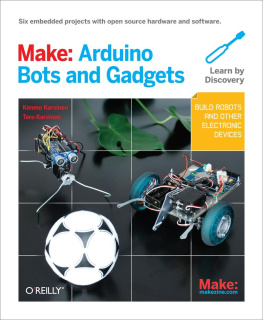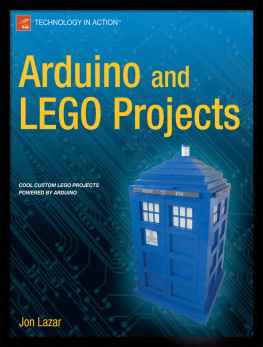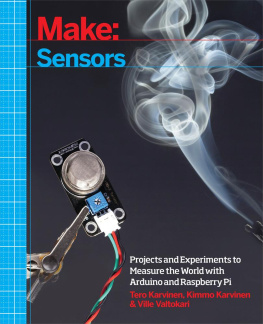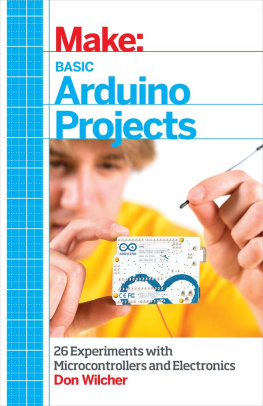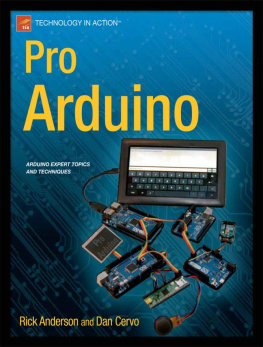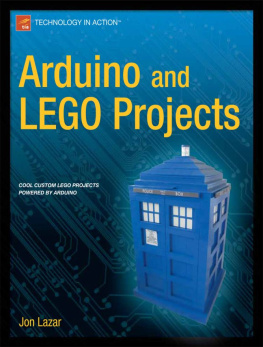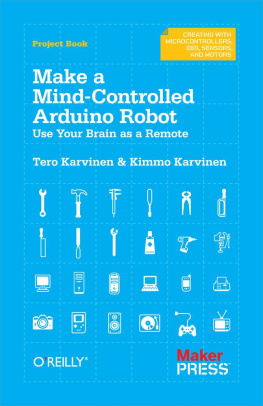Karvinen - Make: Arduino Bots and Gadgets
Here you can read online Karvinen - Make: Arduino Bots and Gadgets full text of the book (entire story) in english for free. Download pdf and epub, get meaning, cover and reviews about this ebook. year: 2011;2009, publisher: Maker Media, Inc, genre: Home and family. Description of the work, (preface) as well as reviews are available. Best literature library LitArk.com created for fans of good reading and offers a wide selection of genres:
Romance novel
Science fiction
Adventure
Detective
Science
History
Home and family
Prose
Art
Politics
Computer
Non-fiction
Religion
Business
Children
Humor
Choose a favorite category and find really read worthwhile books. Enjoy immersion in the world of imagination, feel the emotions of the characters or learn something new for yourself, make an fascinating discovery.
- Book:Make: Arduino Bots and Gadgets
- Author:
- Publisher:Maker Media, Inc
- Genre:
- Year:2011;2009
- Rating:3 / 5
- Favourites:Add to favourites
- Your mark:
- 60
- 1
- 2
- 3
- 4
- 5
Make: Arduino Bots and Gadgets: summary, description and annotation
We offer to read an annotation, description, summary or preface (depends on what the author of the book "Make: Arduino Bots and Gadgets" wrote himself). If you haven't found the necessary information about the book — write in the comments, we will try to find it.
Make: Arduino Bots and Gadgets — read online for free the complete book (whole text) full work
Below is the text of the book, divided by pages. System saving the place of the last page read, allows you to conveniently read the book "Make: Arduino Bots and Gadgets" online for free, without having to search again every time where you left off. Put a bookmark, and you can go to the page where you finished reading at any time.
Font size:
Interval:
Bookmark:

Sebastopol
Supplemental files and examples for this book can be found at http://examples.oreilly.com/0636920010371/. Please use a standard desktop web browser to access these files, as they may not be accessible from all ereader devices.
All code files or examples referenced in the book will be available online. For physical books that ship with an accompanying disc, whenever possible, weve posted all CD/DVD content. Note that while we provide as much of the media content as we are able via free download, we are sometimes limited by licensing restrictions. Please direct any questions or concerns to .
In the early days, embedded systems were built primarily by engineers in a pretty exclusive club. Embedded devices and software tools were expensive, and building a functional prototype required significant software engineering and electrical engineering experience.
With the arrival of Arduino, the open source electronics prototyping platform, things are cheaper and easier. The hardware is inexpensive (around $30), the software is free, and the Arduino environment is designed for artists, designers, and hobbyists rather than engineering professionals.
The ultimate goal of this book is to teach you how to build prototypes using Arduino. Well offer just enough theory to help you apply your new skills to your own projects. You will also become familiar with the logic behind coding and components. We will explain every single line of code and tell you how each component is used. You will learn by completing actual projects, and the knowledge you gain will enable you to further develop your own ideas.
Most books on embedded systems are either so specialized that you need to work within the particular field or too simplistic to be interesting. Books for beginners often just teach you to blindly follow instructions; here, we aim to promote a deeper understanding and a skill set that can be applied more flexibly.
Finally, this book is meant for readers who want to learn how to build prototypes of interesting gadgets, not for those who want to build a dental X-ray machine or a microwave oven. At the same time, you will be able to apply the techniques covered in the book to make prototypes of commercial device concepts.
An embedded system is a microcontroller-based device designed for a very specific purpose. Some examples include washing machines, cell phones, elevators, car brakes, GPS devices, air conditioning units, microwave ovens, wristwatches, and robotic vacuum cleaners. Unlike the user interface youre accustomed to with traditional computers, embedded systems typically do not include a display, mouse, and keyboard. Instead, you might control them via switches and foot pedals, for example.
Most embedded systems are reactive systems, operating in a continuous interaction with their environment and responding within a tempo defined by that environment. This makes them a logical choice for tasks that must react immediately, such as a car braking system.
In some cases, it can be hard to tell whether a particular system should be classified as an embedded system or a computer. For example, cell phones are starting to include more and more features typically associated with computers, but they still have much in common with embedded systems.
The world is already full of embedded systems. With reasonable effort, you can learn how to build one yourself. Turn inventions and ideas into inexpensive prototypes, automate your home by creating a fish-feeding device or controlling lighting from your computer, or build a remote-controlled surveillance camera for your yard that you can access via a computer located anywhere in the world. Artists can create interactive installations or integrate sensors into a game that you can control without touching a computer. Possible implementations are endless.
During the 2000s, the DIY meme gathered more and more popularity, as is evident with the growth of MAKE Magazine and websites such as http://www.instructables.com. The Bay Area Maker Faire, an annual DIY festival, went from 22,000 attendees in its first year (2006) to more than double that amount (45,000) in its second year. And each year, Maker Faire attendance keeps growing.
Learning embedded systems is becoming even more appealing due to the growing interest in robotics. In a 2006 Scientific American article,[] Microsoft founder Bill Gates predicted that robotics would be the next revolution within homes, comparing the current state of the robotics industry to the computing industry in the 1970s. Gates anticipates that robots will soon become a natural part of a home, taking care of simple tasks such as vacuum cleaning, lawn mowing, surveillance, and food service. In addition, because robots can be controlled remotely from anywhere, well be able to use them for telepresenceviewing, hearing, and touching people and things without even having to be present.
The common use of embedded systems is not just the stuff of science fiction or future technology. Its already here and pervasive in the home. Consider air conditioning. A smart air conditioning system adjusts itself based on measurements. How does it know when the air is thick or stale?
Air conditioners measure the temperature, humidity, and sometimes also carbon dioxide levels using sensors. A microcontroller (a small, dedicated computer) follows these measurements, and if the air is damp, for example, it activates a servo that opens an air valve, letting fresh air flow in. This type of intelligent air control system has many benefits. It saves energy, because the air conditioning system doesnt need to be used at full power all the time, and it makes working in such a space more comfortable, because theres neither a constant draft nor stagnant air. The heating and air conditioning system at your own school or job likely functions on the same principles.
Embedded systems include sensors, microcontrollers, and outputs. Sensors measure conditions within a physical environment, such as distance, acceleration, light, pressure, reflection of a surface, and motion.
The microcontroller is the brain of an embedded system. Its a tiny computer, with a processor and memory, which means you can run your own programs on it. The Arduino microcontroller used in this book is programmed using a full-size computer via a USB cable, with sensors and outputs connected to the microcontroller pins.
Outputs affect the physical environment. Examples of outputs youll learn to control in this book include LEDs and servo motors. Output devices are sometimes known as actuators .
This book will teach you the basics of embedded systems in just one week, during which time youll build your first gadget. After that, you can move on to more complex projects and prototypes based on your own ideas. Within seven days, you will already be deep within the world of embedded systems.
This goal can sound immenseat least, we felt it was impossible before we became familiar with contemporary development environments. But today, many projects that once felt impossible now seem straightforward.
Font size:
Interval:
Bookmark:
Similar books «Make: Arduino Bots and Gadgets»
Look at similar books to Make: Arduino Bots and Gadgets. We have selected literature similar in name and meaning in the hope of providing readers with more options to find new, interesting, not yet read works.
Discussion, reviews of the book Make: Arduino Bots and Gadgets and just readers' own opinions. Leave your comments, write what you think about the work, its meaning or the main characters. Specify what exactly you liked and what you didn't like, and why you think so.

